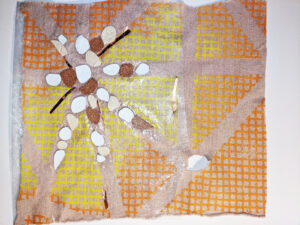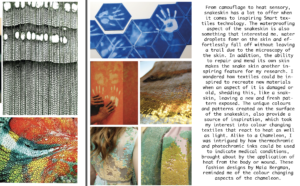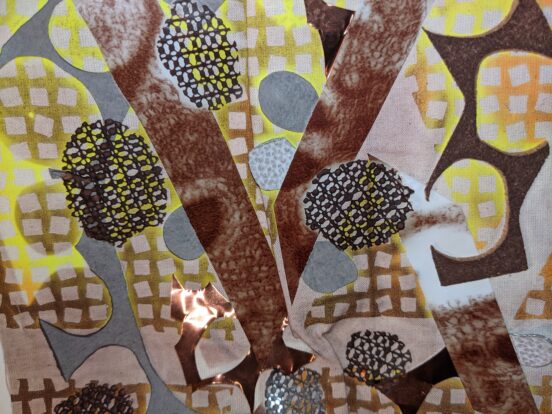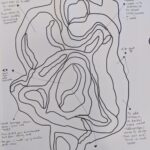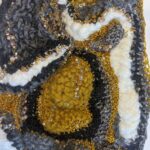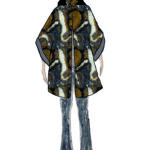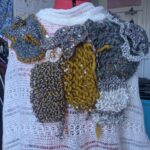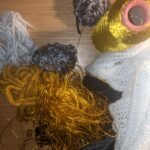For week 5, I have included my final fabric sampling and covering pieces. The initial samples are flat pieces, that don’t necessarily fit around the body, but are deconstructed versions using some of the elements that I have used in my other samples that fit over the body in a more functional way.
The first sample uses the following materials. I have described why I have used them and for what purpose also, in relation to the brief.
Cotton – I used a cotton backing fabric because of its breathable quality. This linked with the brief for a bandage or wound covering that would allow the wound to heal properly, without the risk of constricting the skin or covering the wound too tightly. I also knew from previous projects that cotton still takes up colour from heat transfer paper and disperse dyes, but the colour is more muted and dull. I quite liked the muted effect, as I think it worked with the colour scheme and trying to achieve a natural colour.
String – I used the string purely to experiment with how things could be joined together for the bandage to be functional and flexible around parts of the body. I used the string to create this drawstring effect. I really liked how it manipulated the cotton, adding a new element and aesthetic to the piece.
Shear/Synthetic transparent fabric – Not only for breathability, this fabric could add a shiny aesthetic if placed over another fabric. I wanted to see how I could join this to the main cotton fabric. For this I used vinyl tape and ironed down to experiment with how I could join fabrics together.
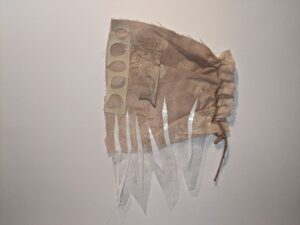
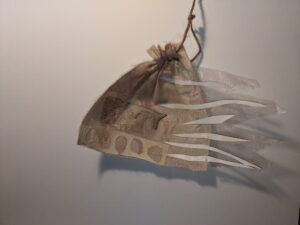
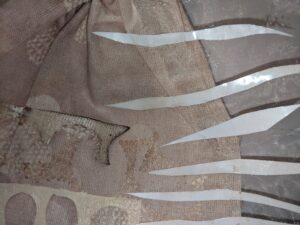
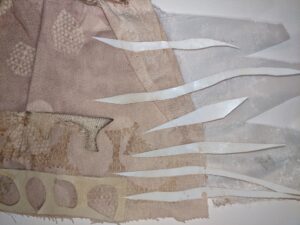
From camouflage to heat sensory, snakeskin has a lot to offer when it comes to inspiring Smart textiles technology. The waterproofing aspect of the snakeskin is also something that interested me. Water droplets form on the skin and effortlessly fall off without leaving a trail due to the microscopy of the skin. In addition, the ability to repair and mend its own skin makes the snake skin another inspiring feature for my research. I wondered how textiles could be inspired to recreate new materials when an aspect of it is damaged or old, shedding this, like a snakeskin, leaving a new and fresh pattern exposed. The unique colours and patterns created on the surface of the snakeskin, also provide a source of inspiration, which took my interest into colour changing textiles that react to heat as well as light. Alike to a Chameleon, I was intrigued by how thermochromic and photochromic inks could be used to indicate medical conditions, brought about by the application of heat from the body or wound.
As shown in the below samples, I have experimented using heat sensitive inks with screen printing and stencil printing. I used a stencil print to create my own pattern, alike to the skin of a chameleon or snake, yet also linking back to the theme of structured pattern, looking at the Pomelo Peel structure and how porous structures can connect and link. In the picture below I have shown the fabric when heat in applied to certain areas. The bright yellow, resembling the vibrant colour of the slime mould, is created when an iron is pressed to it. Because of the arctic temperatures of my flat, I had to use the iron to get a reaction, which then returns to an orange colour when colder, however at room temperature, the textile can be touched and the colour will change instantly when pressed.
